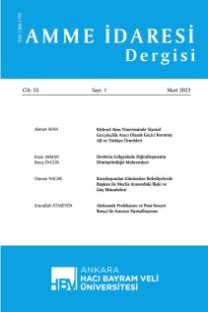İspanya'da Diktatörlükten Demokrasiye Geçiş Süreci: 1975-1982
Transition from Dictatorship to Democracy in Spain: 1975-1982
___
- A Güero, Felipe (1995), "Democratic Consolidation and the Military in Southern Europe and South America", Gunther, Richard/ Diamandouros, P. Nikiioros/ Puhle Hans Jürgen (eds.), The Politics of Democratic Consolidation: Southern Europe in Comparative Perspective, Baltimore: Johns Hopkins University Pres, 124-165.
- Baeza, Alvaro L. (1995), Historia de ETA (1952-1995) Espana: ABL Press, 55. Basım.
- Brassloff, Audrey (1984), "The Church and Post-Franco Society", ABEL, Christopher/ Torrents, Nissa (eds.,), Spain Conditional Democracy, New York: St. Martin's Pres, 59-77.
- Buletin Oficial del Estado (1975), Leyes Fundamentales y Normas Complementariasi, Madrid 10. Basım.
- Carr, Raymond (1970), Espana 1908-1939, Madrid: Editorial Ariel, 2. Basım.
- Carr, Raymond/ Fusi Aızpurua, Juan Pablo (1993), Spain: Dictatorship to Democracy, London, Routledge.
- Colomer, Josep M. (1998), La Transicion a la Democrâcia: El modelo Espanol, Barcelona: Editorial Agrama.
- Contreras Casado, Manuel (1987), "El Modelo Politico del Estado de las Autonomias y la Transicion Espanola a la Democracia" (ayrı bası), Centra Asociado de Barbastro, Tomo IV.
- Fernandez De Castro, Ignacio (1981), De las Cortes de al Posfranquismo 1808-1956, Barcelona, Ediciones 2001.
- Gilmour, David (1985), The Transformation of Spain- From Franco to the Constitutional Monarchy, London: Quartet Books.
- Gunther, Richard/ Sani, Giacoma/ Shabad, Goldie (1988), Spain After Franco. The Making of a Competitive Party System, University of California Press.
- Labastida, Horacio (1994), Las Constituciones Espanolas, Mexico: Universidad Autonoma de Mexico.
- Linz, Juan J. (1964), " an Authoritarian Regime: Spain", Allardt, Erik/ Littunen, Yrjö (eds.), Cleavages, Ideologies and Party Systems, Helsinki: Transactions of the Wastermarck Society, 291-341.
- Linz, Juan J. (2000), Totalitarian and Authoritarian Regime, London: Lynne Reienner Publishers.
- Maravall, Jose Maria (1982), The Transition to Democracy in Spain, New York: St. Martin's Press.
- Maravall, Jose Maria/ Santamaria, Julian (1986), "Political Change in Spain and the Prospects for Democracy", O'donnell, Guillermo/ Schmıtter, Philippe C./ Whitehead Laurence (eds.), Transitions from Authoritarian Rule: Southern Europe, Baltimore: Johns Hopkins University Press, 71-108.
- Özçer, Akın (1999), İspanya Siyasi Tarihinde Bask Milliyetçiliği, I. ve II. Ciltler, İstanbul, Doğan Kitap.
- Payne, Stanley G. (1976), Franco's Spain, London: Routledge & Kegan Paul.
- Perez-Diaz, Victor M. (1993), The Return of Civil Society, Harvard University Press.
- Perez Hernandez, Antonio (1965), El Consejo de Estado, Madrid: Estudios Administrativos.
- Ramirez, Manuel (1978), Espana 1939-1975, Madrid: Gudarrama.
- Ramon Arango, E. (1995), Spain: Democracy Regained, USA: Westview Press, 2. Basım.
- Share, Donald (1986), The Making of Spanish Democracy, New York: Praeger.
- Share, Donald (1987), "Transitions to Democracy and Transition trough Transaction", Comparative Political Studies, Sayı 19, Ocak, 525-548.
- Sole Tura, Jordi /AJA, Eliseo (1992), Constituciones y Periodos Constituyentes en Espana (1808-1936), Madrid: Siglo Veintiuno de Espana Editores, 16. Basım.
- Sole Tura, Jordi (1985), Nacionalidades y Nacionalismos en Espana, Madrid: Alianza Editorial.
- Torres Del Moral, Antonio (1987), Constitucionalismo Historico Espanol, Madrid: Atomo Editorial.
- Tusell, Javier (1997), La Transicion Espanola a la Democrâcia, Madrid: S.L. El Pais.
- ISSN: 1300-1795
- Yayın Aralığı: 4
- Başlangıç: 1968
- Yayıncı: -
İspanya'da Diktatörlükten Demokrasiye Geçiş Süreci: 1975-1982
Halkla İlişkilerin İdeolojik Bir Yöntem Olarak İşleyişi
Bir Meşrulaştırım Yöntemi Olarak Halkla İlişkilerin Meşruiyeti
Türk Kamu Yönetim Sisteminin Yeniden Örgütlenmesi Üzerine Düşünceler
Tarım Kesiminin Kalkınmasında Bir Çözüm Olarak Arazi Toplulaştırması
Toplam Kalite Yönetimi ve Yönetim Teorisi
